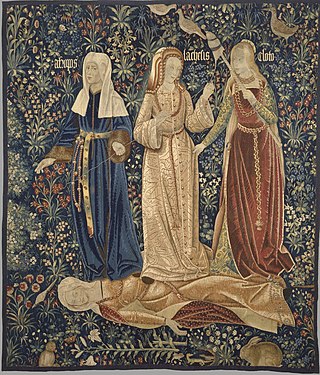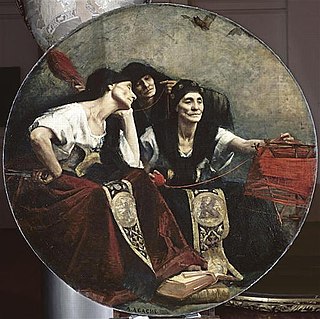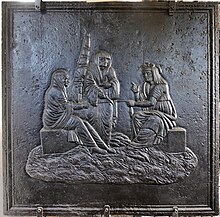
In ancient Greek religion and mythology, the Moirai often known in English as the Fates—were the personifications of destiny. They were three sisters: Clotho, Lachesis, and Atropos. Their Roman equivalent is the Parcae.

Clotho or Klotho, is a mythological figure. She is the youngest goddess of the Three Fates or Moirai. In ancient Greek mythology, she spins the thread of human life, her sisters draw out (Lachesis) and cut (Atropos) the thread. Her Roman equivalent is Nona. She also made major decisions, such as when a person was born, thus in effect controlling people's lives. This power enabled her not only to choose who was born, but also to decide when deities or mortals were to be saved or put to death. For example, Clotho resurrected Pelops when his father killed him.

Atropos, in Greek mythology, was one of the three Moirai, goddesses of fate and destiny. Her Roman equivalent was Morta.
In Greek mythology, Moros /ˈmɔːrɒs/ or Morus /ˈmɔːrəs/ is the 'hateful' personified spirit of impending doom, who drives mortals to their deadly fate. It was also said that Moros gave people the ability to foresee their death. His Roman equivalent was Fatum.
Destiny, sometimes also called fate, is a predetermined course of events. It may be conceived as a predetermined future, whether in general or of an individual.

Juno was an ancient Roman goddess, the protector and special counsellor of the state. She was equated to Hera, queen of the gods in Greek mythology and a goddess of love and marriage. A daughter of Saturn and Ops, she was the sister and wife of Jupiter and the mother of Mars, Vulcan, Bellona, Lucina and Juventas. Like Hera, her sacred animal was the peacock. Her Etruscan counterpart was Uni, and she was said to also watch over the women of Rome. As the patron goddess of Rome and the Roman Empire, Juno was called Regina ("Queen") and was a member of the Capitoline Triad, centered on the Capitoline Hill in Rome, and also including Jupiter, and Minerva, goddess of wisdom.

Lachesis, in ancient Greek religion, was the middle of the Three Fates, or Moirai; the others were her sisters, Clotho and Atropos. Normally seen clothed in white, Lachesis is the measurer of the thread spun on Clotho's spindle, and in some texts, determines Destiny, or thread of life. Her Roman equivalent was Decima. Lachesis was the apportioner, deciding how much time for life was to be allowed for each person or being. She measured the thread of life with her rod. She is also said to choose a person's destiny after a thread was measured. In mythology, it is said that she appears with her sisters within three days of a baby's birth to decide the baby's fate.

Nona was one of the Parcae, the three personifications of destiny in Roman mythology, and the Roman goddess of pregnancy. The Roman equivalent of the Greek Clotho, she spun the thread of life from her distaff onto her spindle. Nona, whose name means "ninth", was called upon by pregnant women in their ninth month when the child was due to be born.

Gallo-Roman religion is a fusion of the traditional religious practices of the Gauls, who were originally Celtic speakers, and the Roman and Hellenistic religions introduced to the region under Roman Imperial rule. It was the result of selective acculturation.
In ancient Roman myth and literature, Mors is the personification of death equivalent to the Greek Thanatos. The Latin noun for "death," mors, genitive mortis, is of feminine gender, but surviving ancient Roman art is not known to depict death as a woman. Latin poets, however, are bound by the grammatical gender of the word. Horace writes of pallida Mors, "pale Death," who kicks her way into the hovels of the poor and the towers of kings equally. Seneca, for whom Mors is also pale, describes her "eager teeth." Tibullus pictures Mors as black or dark.

The Fates are a common motif in European polytheism, most frequently represented as a trio of goddesses. The Fates shape the destiny of each human, often expressed in textile metaphors such as spinning fibers into yarn, or weaving threads on a loom. The trio are generally conceived of as sisters and are often given the names Clotho, Lachesis, and Atropos, which are the names of the Moirai, the version of the Fates who appear in Greek mythology. These divine figures are often artistically depicted as beautiful maidens with consideration to their serious responsibility: the life of mortals. Poets, on the other hand, typically express the Fates as ugly and unwavering, representing the gravity of their role within the mythological and human worlds.
A triad, in a religious context, refers to a grouping of three gods, usually by importance or similar roles. A triad of gods were usually not considered to be one in the same being, or different aspects of a single deity as in a Trinity or Triple deity.
Time and fate deities are personifications of time, often in the sense of human lifetime and human fate, in polytheistic religions. In monotheism, Time can still be personified, like Father Time.

Decima was one of the three Parcae in Roman mythology. The Parcae goddess Nona was responsible for pregnancy; Decima was responsible for birth; and Morta was charged with overseeing death. They distributed to mankind all the good and bad things in life, and according to some classical writings even Jupiter had to bend to their will. Decima measured the thread of life with her rod, like her Greek equivalent Lachesis. In some accounts, her mother was Nox the goddess of night and her father was Erebus the god of darkness; while in other accounts, her parents were Jupiter and Themis.

Saturn was a god in ancient Roman religion, and a character in Roman mythology. He was described as a god of time, generation, dissolution, abundance, wealth, agriculture, periodic renewal and liberation. Saturn's mythological reign was depicted as a Golden Age of abundance and peace. After the Roman conquest of Greece, he was conflated with the Greek Titan Cronus. Saturn's consort was his sister Ops, with whom he fathered Jupiter, Neptune, Pluto, Juno, Ceres and Vesta.

The di inferi or dii inferi were a shadowy collective of ancient Roman deities associated with death and the underworld. The epithet inferi is also given to the mysterious Manes, a collective of ancestral spirits. The most likely origin of the word Manes is from manus or manis, meaning "good" or "kindly," which was a euphemistic way to speak of the inferi so as to avert their potential to harm or cause fear.
In ancient Rome the dies lustricus was a traditional naming ceremony in which an infant was purified and given a praenomen. This occurred on the eighth day for girls and the ninth day for boys, a difference Plutarch explains by noting that "it is a fact that the female grows up, and attains maturity and perfection before the male." Until the umbilical cord fell off, typically on the seventh day, the baby was regarded as "more like a plant than an animal," as Plutarch expresses it. The ceremony of the dies lustricus was thus postponed until the last tangible connection to the mother's body was dissolved and the child was seen "as no longer forming part of the mother, and in this way as possessing an independent existence which justified its receiving a name of its own and therefore a fate of its own." The day was celebrated with a family feast. The childhood goddess Nundina presided over the event, and the goddess Nona was supposed to determine a person's lifespan. Prior to the ceremony infants were not considered part of the household, even if their father had raised them up during a tollere liberum.













